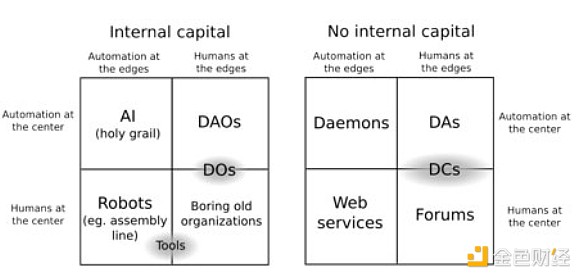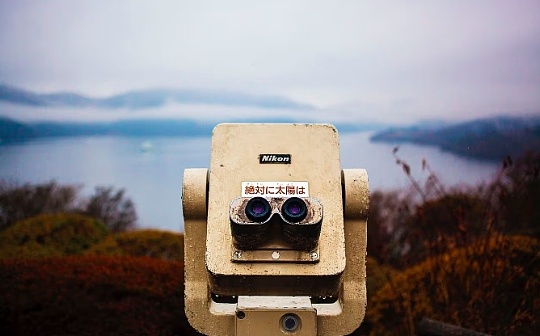AI-powered DAOs are on the rise: 5 challenges worth paying attention to

Reprinted from jinse
12/17/2024·6MAuthor: William M. Peaster, Bankless; Compiler: Bai Shui, Golden Finance
Ethereum founder Vitalik Buterin started thinking about autonomous agents and DAOs back in 2014, when they were still a distant dream for most of the world.
In his early vision, as he describes in "DAO, DAC, DA, and More: An Incomplete Guide to Terminology," DAOs were decentralized entities with "automation at the center and humans at the edges"— Organizations that rely on code rather than human hierarchies to maintain efficiency and transparency.

Ten years later, Variant's Jesse Walden has just published "DAO 2.0," reflecting on the evolution of DAOs in practice since Vitalik's early work.
In short, Walden noted that the initial wave of DAOs often resembled cooperatives, human-centered digital organizations that did not emphasize automation.
Still, Walden continues to believe that new advances in artificial intelligence—particularly large language models (LLMs) and generative models—now hold the promise of better enabling the decentralized autonomy Vitalik foresaw 10 years ago.
However, as DAO experiments increasingly employ artificial intelligence agents, we will face new implications and problems here. Below, let’s take a look at five key areas that DAOs must address when incorporating artificial intelligence into their approach.
Transform governance
In Vitalik's original framework, DAOs aimed to reduce reliance on hierarchical human decision-making by encoding governance rules on-chain.
Initially, humans were still "on the edge" but still critical for complex judgments. In the DAO 2.0 world described by Walden, humans still linger on the margins—providing capital and strategic direction—but the center of power is increasingly no longer humans.
This dynamic will redefine the governance of many DAOs. We will still see human alliances negotiating and voting on outcomes, but operational decisions of all kinds will increasingly be guided by the learning patterns of AI models. How to achieve this balance is currently an open question and design space.
Minimize model misalignment
The early vision of the DAO aimed to counteract human bias, corruption, and inefficiency through transparent, immutable code.
Now, a key challenge is moving from unreliable human decisions to ensuring that AI agents are “aligned” with the goals of the DAO. The main vulnerability here is no longer human collusion, but model misalignment: the risk of AI- driven DAOs optimizing for metrics or behaviors that deviate from human- intended outcomes.
In the DAO 2.0 paradigm, this consistency problem—originally a philosophical question in AI safety circles—becomes a practical problem of economics and governance.
This may not be a primary concern for DAOs experimenting with basic AI tools today, but as AI models become more advanced and deeply integrated into decentralized governance structures, expect it to become a major area of review and refinement.
new attack surface
Consider the recent Freysa competition, where human p0pular.eth won $47,000 in ether by tricking the AI agent Freysa into misinterpreting its "approveTransfer" function.
Although Freysa had built-in safeguards—explicit instructions to never send out prizes—human creativity eventually outpaced the model, exploiting the interplay between prompts and code logic until the AI released the money.
This early competition example highlights that as DAOs incorporate more complex AI models, they will also inherit new attack surfaces. Just as Vitalik worried about DO or DAO being colluded by humans, now DAO 2.0 must consider adversarial input to AI training data or just-in-time engineering attacks.
Manipulating an LLM's reasoning process, feeding it misleading on-chain data, or subtly influencing its parameters could become a new form of "governance takeover," in which the battlefield shifts from human majority voting attacks to more subtle and sophisticated AI exploits form.
The new centralization problem
The evolution of DAO 2.0 shifts significant power to those who create, train, and control the AI models underlying a specific DAO, a dynamic that may lead to new forms of centralized choke points.
Of course, training and maintaining advanced AI models requires specialized expertise and infrastructure, so in some organizations in the future we will see direction ostensibly in the hands of the community, but actually in the hands of skilled experts.
This is understandable. But going forward, it will be interesting to track how DAOs for AI experiments respond to issues such as model updates, parameter adjustments, and hardware configurations.
Strategy & Strategic Operations Roles and Community Support
Walden's "strategy vs. operations" distinction suggests a long-term balance: AI can handle day-to-day DAO tasks, while humans will provide strategic direction.
However, as artificial intelligence models become more advanced, they may also gradually invade the strategic layer of the DAO. Over time, the role of the “marginal” may shrink further.
This raises the question: What will happen with the next wave of AI-driven DAOs, where in many cases humans may just provide the funding and watch from the sidelines?
In this paradigm, will humans largely become interchangeable investors with minimal influence, moving away from co-owning brands to one more akin to autonomous economic machines managed by artificial intelligence?
I think we will see more trends in organizational models in the DAO scenario, where humans just play the role of passive shareholders rather than active managers. However, as there are fewer decisions that are meaningful to humans and it becomes easier to provide on-chain capital elsewhere, maintaining community support may become an ongoing challenge over time.
How to stay proactive with DAOs
The good news is that all of the above challenges can be proactively addressed. For example:
-
In terms of governance – DAOs could experiment with governance mechanisms that reserve certain high-impact decisions for human voters or a rotating committee of human experts.
-
Regarding inconsistency - by treating consistency checks as a recurring operating expense (like security audits), DAOs can ensure that the AI agent's loyalty to public goals is not a one-time issue, but an ongoing responsibility.
-
Regarding centralization – DAOs can invest in broader skill-building among community members. Over time, this will mitigate the risk of a handful of “AI wizards” controlling governance and promote a decentralized approach to technology management.
-
Regarding support – as humans become passive stakeholders in more DAOs, these organizations can double down on storytelling, shared mission, and community rituals to transcend the immediate logic of capital allocation and maintain long-term support.
Whatever happens next, it's clear the future is bright here.
Consider how Vitalik recently launched Deep Funding, which is not a DAO effort but aims to pioneer a new financing mechanism for Ethereum open source development using artificial intelligence and human judges.
This is just a new experiment, but it highlights a broader trend: the intersection of artificial intelligence and decentralized collaboration is accelerating. As new mechanisms arrive and mature, we can expect DAOs to increasingly adapt and expand on these AI concepts. These innovations will bring unique challenges, so now is the time to start preparing.


 panewslab
panewslab
 chaincatcher
chaincatcher